.
2.08.2015
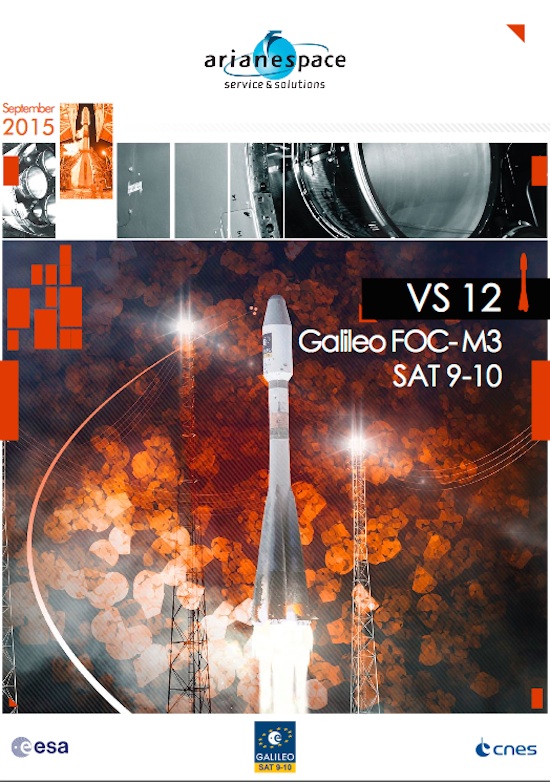

Soyuz Flight VS12
Arianespace is gearing up this week for its upcoming Soyuz Flight VS12 – scheduled for September 10 from French Guiana – with initial fit-check activities completed for the mission’s two passengers: the latest European Galileo navigation satellites.
During activity inside the Spaceport’s S1A clean room facility, the correct fit was confirmed for the Galileo spacecraft on their specially-designed payload dispenser, which will hold the satellites in a side-by-side configuration atop Soyuz’ Fregat upper stage during the mission and deploy them at the orbital insertion point.
As part of this process, the spacecraft – which are the fifth and sixth in Galileo’s full operational capability (FOC) phase – are installed separately, then removed from, the RUAG Space Sweden-built dispenser that uses a pyrotechnic separation system to release them in opposite directions during the flight.
Completion of the fit-check allows the next stage of payload preparations to begin, including fueling, final integration with the payload dispenser, and the completed unit’s subsequent installation on Arianespace’s medium-lift workhorse Soyuz vehicle.
Galileo’s FOC phase is managed and funded by the European Commission, with the European Space Agency delegated as the design and procurement agent on the Commission’s behalf. The latest Galileo FOC spacecraft were produced by OHB System, with Surrey Satellite Technology Ltd. supplying their navigation payloads that will generate precise positioning measurements and services around the world.
At full deployment, the Galileo program will consist of 30 satellites – comprising operational spacecraft and reserves – situated on three circular medium Earth orbits at some 23,200 km. altitude inclined 56 deg. to the equator. The constellation – and associated ground infrastructure – will provide high-quality positioning, navigation and timing services under civilian control, and be interoperable with the U.S. GPS and Russian Glonass global positioning systems.
This week’s processing with the Galileo satellites is part of Arianespace’s busy operational pace in French Guiana, where payload and launcher activity has commenced for four upcoming missions: Ariane 5 Flight VA225, Soyuz Flight VS12, Ariane 5 Flight VA226 and Vega Flight VV06.
Arianespace’s Flight VS12 is planned to be the company’s eighth launch this year, following August 20’s scheduled Ariane 5 Flight VA225, as well as six successful missions already completed in 2015 – comprising separate flights of three Ariane 5s, two Vega vehicles, and a Soyuz launcher.
Quelle: arianespace
-
Update: 30.08.2015
.
Fueled for flight: Galileo satellites are “topped off” for Arianespace's upcoming Soyuz launch
Soyuz Flight VS12
The two European Galileo navigation satellites for Arianespace’s next mission from French Guiana have been fueled at the Spaceport, readying them for integration with their Soyuz launcher.
These spacecraft were “topped off” during activity this week at the Spaceport’s S3B payload preparation facility, further advancing preparations for the September 10 mission – which is designated Flight VS12 in Arianespace’s launcher family numbering system, signifying the 12th liftoff of the medium-lift Soyuz vehicle from French Guiana.
.
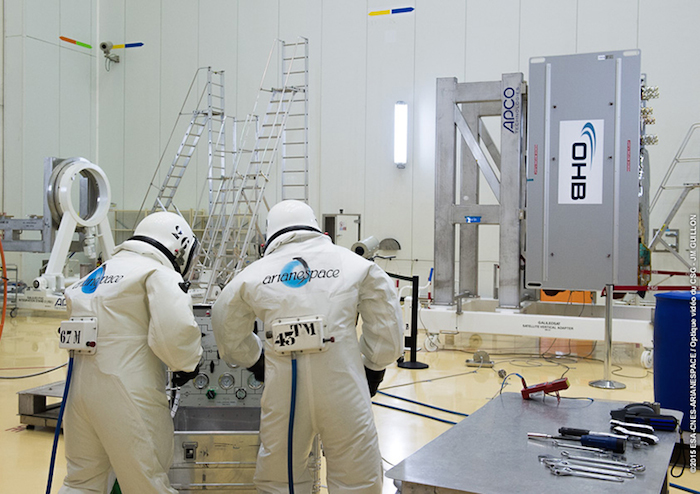
One of the two Galileo full operational capability satellites for Arianespace’s Flight VS12 Soyuz mission is fueled in the Spaceport’s S3B payload preparation facility.
.
Flight VS12’s satellites are the fifth and sixth in Galileo’s full operational capability (FOC) phase. They were produced by OHB System, with Surrey Satellite Technology Ltd. supplying their navigation payloads that will generate precise positioning measurements and services around the world.
The September 10 mission will be the fifth Soyuz flight with Galileo satellites performed by Arianespace from French Guiana – a series that began with the Russian-built launcher’s inaugural liftoff at the Spaceport in October 2011.
At full deployment, the Galileo program will consist of 30 satellites – comprising operational spacecraft and reserves – situated on three circular medium Earth orbits at some 23,200 km. altitude inclined 56 deg. to the equator. This constellation – and associated ground infrastructure – will provide high-quality positioning, navigation and timing services under civilian control, and be interoperable with the U.S. GPS and Russian Glonass global positioning systems.
Galileo’s FOC phase is managed and funded by the European Commission, with the European Space Agency delegated as the design and procurement agent on the Commission’s behalf.
Arianespace Flight VS12 will be the company’s eighth mission this year, following the successful launches in 2015 of four heavy-lift Ariane 5s, two lightweight Vega vehicles, and one Soyuz.
.

Quelle: ESA
-
Update: 5.09.2015
.
The Spaceport’s new FCube facility enters operations with its first fueling of a Soyuz launcher’s Fregat upper stage
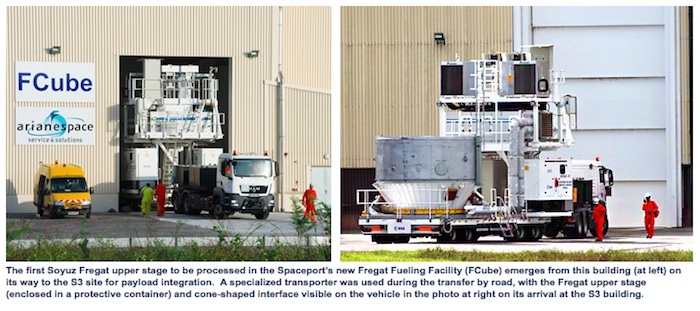
Processing has been completed for the initial Soyuz Fregat upper stage to be handled in the Spaceport’s Fregat Fueling Facility (FCube) – the newest site in French Guiana to support Arianespace’s sustained operational cadence.
This milestone Fregat will be used for the upcoming Arianespace medium-lift Soyuz mission, which is set for September 10 with two European Galileo navigation satellites.
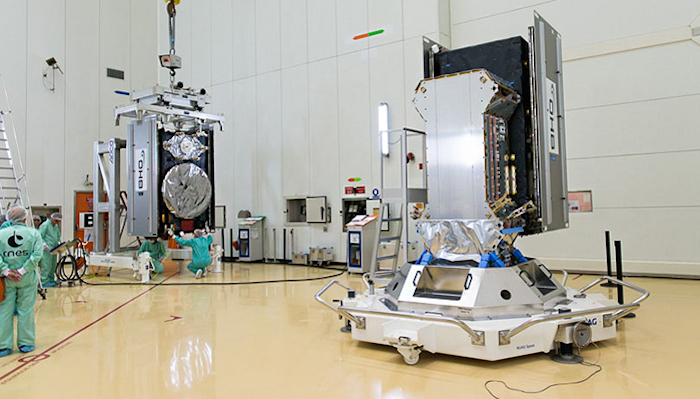
The FCube was developed to reduce the time required to “top off” Fregat upper stages, which takes several weeks as part of Soyuz launch campaigns. It also frees up another Spaceport facility previously used for Fregat upper stage fueling operations – the Spaceport’s S3 building, making the S3 facility more available for the processing of customer spacecraft to be lofted by the various members of Arianespace’s launch vehicle family.
Qualified to Class 300,000 clean room conditions, the FCube is tailored for Fregat upper stage fueling in a process that involves the loading of UDMH and N2O4 storable propellants, along with N2H4 for attitude control, and helium for propellant tank pressurization. With Arianespace’s overall mission flexibility in mind, the FCube also could be used in the future for fueling small-sized satellite payloads.
The FCube consists of two structures: one building that serves as the remote control center and includes a zone where fueling operators are suited up in their protective clothing; and the other with the Fregat fueling hall, along with the storage for propellant and gases, and areas to hold support and spare equipment.
Fregat is an autonomous and flexible upper stage that extends the Russian-built Soyuz’ capability to perform a full range of missions (to medium-Earth orbit, Sun-synchronous orbit, geostationary transfer orbit and Earth escape trajectories), and can be restarted up to 20 times in flight – enabling it to carry out complex flight profiles.
The Fregat upper stage is manufactured by NPO Lavochkin, which is part of Soyuz’ Russian industrial team. RKTs-Progress (the Samara Space Center) is responsible for the design, development, and manufacture of Soyuz’ three lower stages and payload fairing, as well as for integrating the launch vehicle stages and handling flight operations.
With the first Fregat having now been fueled in the FCube, this upper stage was moved across the Spaceport today to the S3 facility for Flight VS12’s next phase of payload integration. While in the S3 building, the two Galileo satellites and their dispenser system will be integrated on Fregat, followed by their encapsulation in Soyuz’ payload fairing to create the launcher’s “upper composite.”
The completed upper composite will then be ready for transfer to the Spaceport’s ELS launch complex, where it will be installed atop Flight VS12’s Soyuz, enabling the nighttime liftoff on a September 10 mission lasting just under 3 hours, 48 minutes.
Quelle: arianespace
-
The two Galileo satellites are integrated for Arianespace’s next Soyuz mission from French Guiana

The Galileo FOC Flight Model 6 satellite – one of the two Galileo co-passengers Arianespace’s upcoming Soyuz mission – is shown during its transfer inside the Spaceport’s S3B clean room facility for integration on the dispenser system. At right is the dispenser, with the already-installed FOC Flight Model 5 spacecraft.
-
Both Galileo navigation satellites for Arianespace’s September 10 launch have been installed on their side-by-side dispenser system, marking another milestone in preparations for the upcoming mission from French Guiana with the company’s workhorse medium-lift Soyuz.
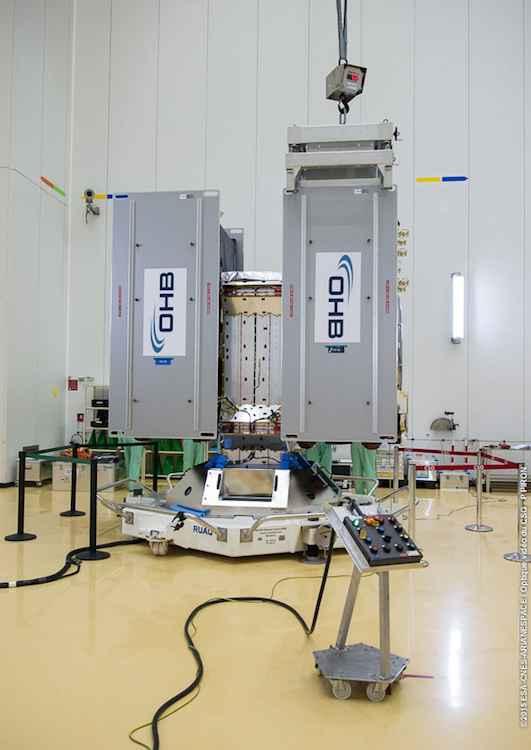

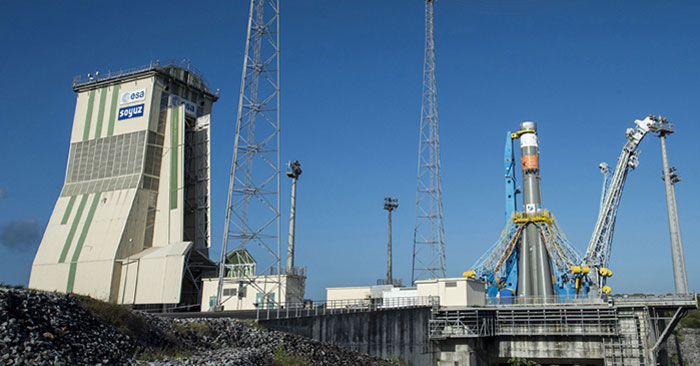
Operating in the Spaceport’s S3B clean room facility, mission team members mated the spacecraft pair with the dispenser, which will deploy the satellites by firing a pyrotechnic system for separation in opposite directions at the orbital insertion point.
These are the fifth and sixth FOC (Full Operational Capability) spacecraft in Europe’s Galileo navigation program, and have been designated “Alba” and “Oriana” – continuing the naming process after children who won a painting competition organized by the European Commission in 2011.
With this step now complete, the satellite/dispenser combination is ready for integration on Soyuz’ Fregat upper stage, followed by the payload fairing encapsulation. This will create the “upper composite,” which is to be installed atop Soyuz once the vehicle has been moved to its Spaceport launch zone.
Galileo’s FOC phase is managed and funded by the European Commission, with the European Space Agency (ESA) delegated as the design and procurement agent on the Commission’s behalf.
Germany’s OHB System is industrial prime contractor to ESA for the FOC satellites, while Surrey Satellite Technology Limited – an independent British company within the Airbus Defence and Space group – supplies their navigation payloads that generate precise positioning measurements and services around the world.
The Galileo system will provide high-quality positioning, navigation and timing services under civilian control, and is designed for interoperability with the U.S. GPS and Russian Glonass global positioning systems.
Arianespace’s September 10 mission is designated Flight VS12 in the company’s launcher family numbering system, designating the 12th launch with Soyuz from the Spaceport.
.

Using an overhead crane, the Galileo FOC Flight Model 6 satellite is moved into position for installation on the dispenser. The Flight Model 5 spacecraft was previously integrated on the dispenser’s left side. Cover plates with the logo of prime contractor OHB System protect the satellites’ deployable solar panels during ground operations.

Quelle: arianespace
.
Update: 7.09.2015
.
Rollout! Soyuz is in the launch zone for Arianespace’s next mission to launch Galileo navigation satellites

The Soyuz for Arianespace’s Flight VS12 is shown after being suspended over the launch pad by four support arms. At left is the 53-meter-tall mobile gantry, ready for its move-in to protect Soyuz during the integration of its “upper composite.”
-
Soyuz Flight VS12
The 12th Soyuz to be operated from the Spaceport is now in the launch zone following this workhorse medium-lift vehicle’s rollout in French Guiana on a mission to orbit two more European Galileo navigation satellites.
Using the procedures that have been followed since Russia’s Soyuz ushered in the Space Age, the basic three-stage vehicle for Arianespace’s September 10 Flight VS12 rolled out from its MiK integration building in the Spaceport’s northwestern sector this morning, and was transferred horizontally to the ELS launch zone by a transporter/erector rail car.
The Soyuz was then erected in its vertical position and suspended over the launch pad, to be held in place by four large support arms. This was followed by the 53-meter-tall mobile gantry’s move-in to protect the launcher, providing a safe environment for installation of the “upper composite” – consisting of two Galileo spacecraft, the Soyuz’ Fregat upper stage and a two-piece protective payload fairing.
Flight VS12’s passengers are the fifth and sixth FOC (Full Operational Capability) spacecraft in Europe’s Galileo navigation program, and have been designated “Alba” and “Oriana” – continuing the naming process after children who won a painting competition organized by the European Commission in 2011.
These satellites were built by OHB System, with Surrey Satellite Technology Ltd. supplying their navigation payloads.
The European Commission is managing and funding Galileo’s FOC phase – during which the network’s complete operational and ground infrastructure is being deployed. The European Space Agency has been delegated as the design and procurement agent on the Commission’s behalf.
---
Next Arianespace launch will orbit Galileo satellites using Soyuz launcher
Evry, September 7, 2015
On its eighth launch of 2015 and the 12th Soyuz launch from the Guiana Space Center, Arianespace will orbit the two latest satellites in the Galileo global navigation system. Carried out on behalf of the European Commission, under a European Space Agency (ESA) contract, this launch will orbit the ninth and tenth Galileo FOC (Full Operational Capacity) satellites.
The launch will be carried out from the Soyuz launch complex (ELS) in Sinnamary, French Guiana.
Orbit: circular medium Earth orbit (MEO)
Altitude: 23,522 km
Inclination: 57.4 degrees
Liftoff is scheduled for Thursday, September 10, 2015, at:
11:08:10 pm, local time in French Guiana,
10:08:10 pm, in Washington, DC,
and on Friday, September 11 at:
02:08:10 UTC,
4:08:10 am, in Paris,
6:08:10 am, in Moscow.
The mission (from liftoff to satellite release) will last approximately 3 hours and 48 minutes.
The launcher will be carrying a total payload of 1,601 kg, including 1,431 kg for the two Galileo satellites.
The Launch Readiness Review (LRR) will take place on Wednesday, September 9, 2015 in French Guiana, to authorize the start of operations for the final countdown.
Galileo, an emblematic European program
Galileo, a new global satellite navigation system, is an emblematic European Union program lead by DG Grow entity and managed by ESA as prime contractor.
The Galileo FOC (Full Operational Capacity) satellites are built in Europe by OHB System of Bremen, Germany as prime contractor, with all payloads supplied by SSTL (Surrey Satellite Technology Ltd.), a British subsidiary of Airbus Defence and Space.
Quelle: arianespace
-
Update: 9.09.2015
.
Galileo 9 and 10 in the Zone for This Week’s Launch
Galileo 9 and 10 are ready for launch atop a Soyuz rocket at 23:08 local time on Sept. 10 (02:08 GMT and 04:08 CEST on Sept. 11) from Europe’s Spaceport in French Guiana.
After being attached to their carrier last week, the pair of fully fueled satellites was carefully lowered onto the Fregat upper stage on Wednesday, Sept. 2, in the 3SB preparation building of the Guiana Space Centre. The following day was devoted to functional checks and inspections, preparing the Galileos plus Fregat to be encapsulated within the halves of their Soyuz rocket fairing, which took place on Sept. 4. This complete “upper composite” was then transported to the launch site and attached vertically to the first three stages of the Soyuz ST-B, the 12th Soyuz to be operated from the spaceport.
As much a spacecraft as a launcher stage, the re-ignitable Fregat will take the Galileos the bulk of the way to their designated medium-altitude orbit once the first three stages achieve low orbit, 9 minutes and 24 seconds after launch. A pair of Fregat firings will be separated by a 3-hour, 13-minute coast up to their target 23,222 km orbital altitude and 57.394° inclination.
Soyuz in Launch Zone. The basic three-stage vehicle for Arianespace’s Sept. 10 Flight VS12 rolled out from its MiK integration building in the Spaceport’s northwestern sector this morning, and was transferred horizontally to the ELS launch zone by a transporter/erector rail car.
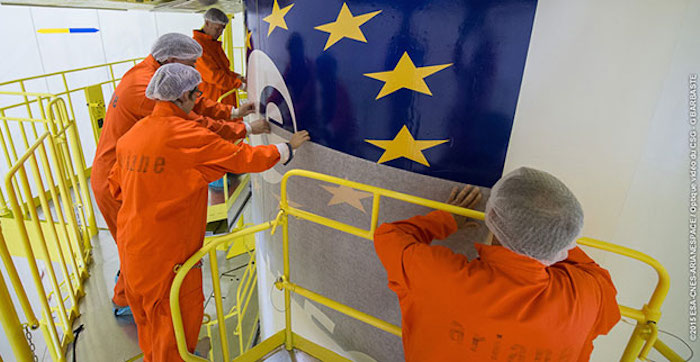


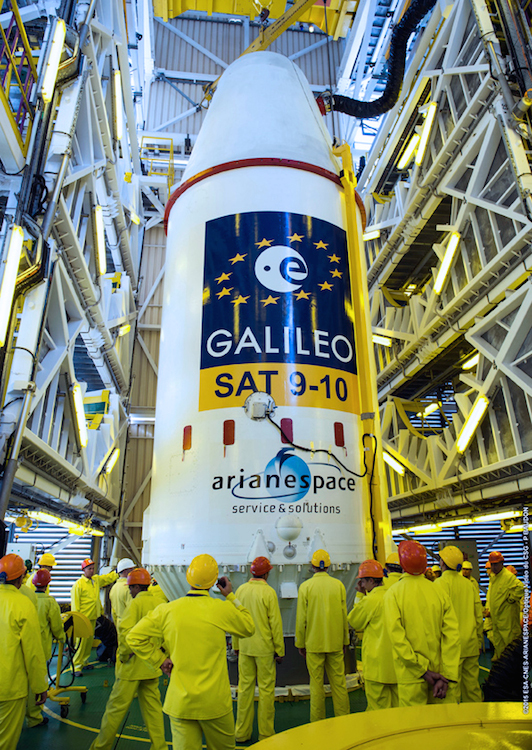
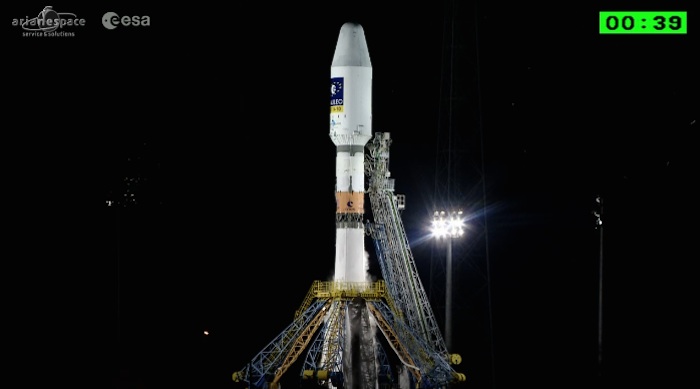
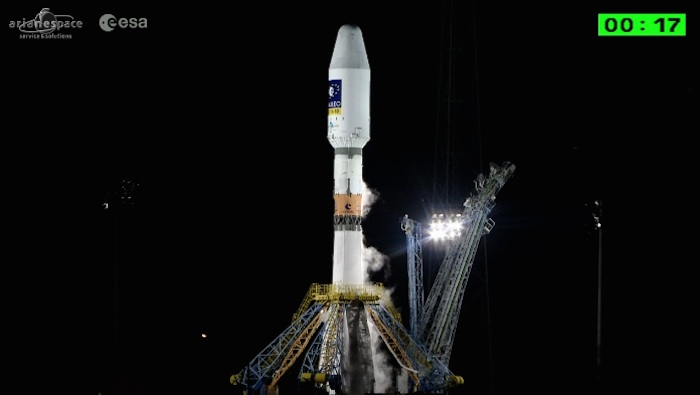
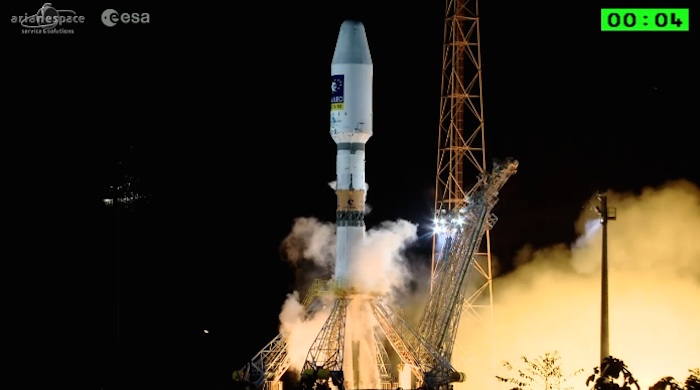
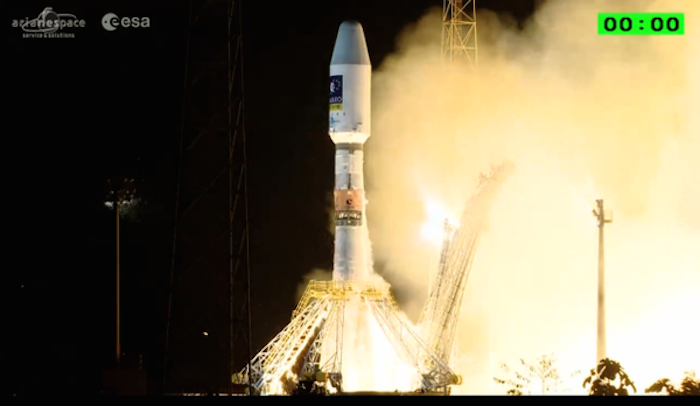
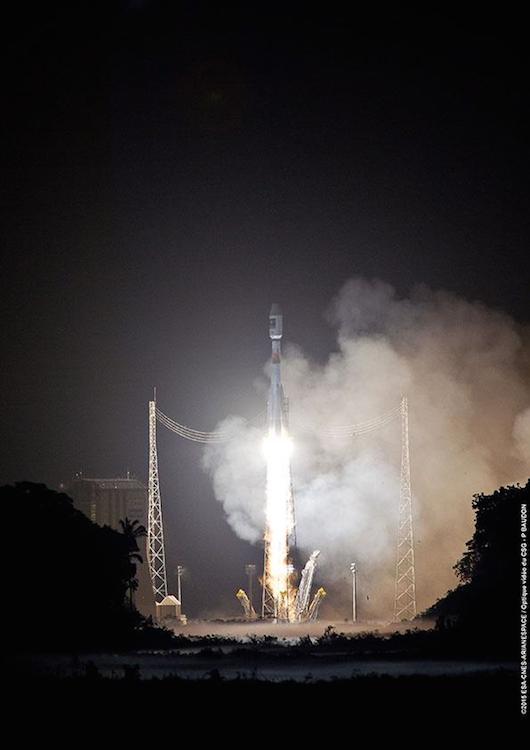
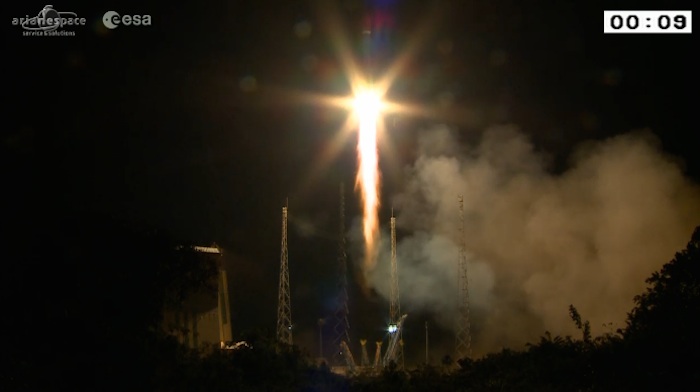
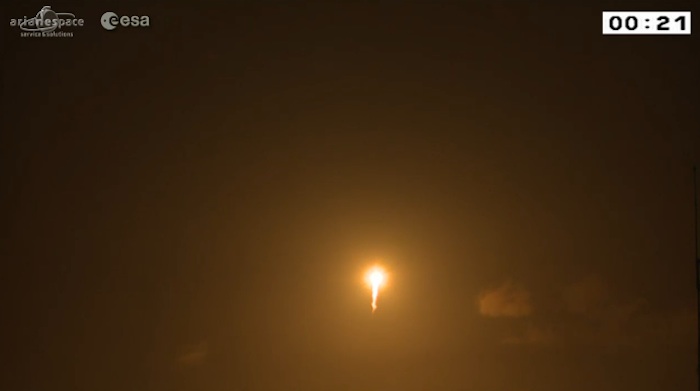

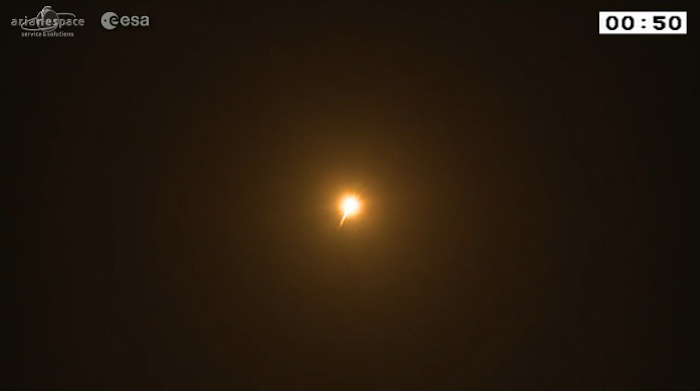
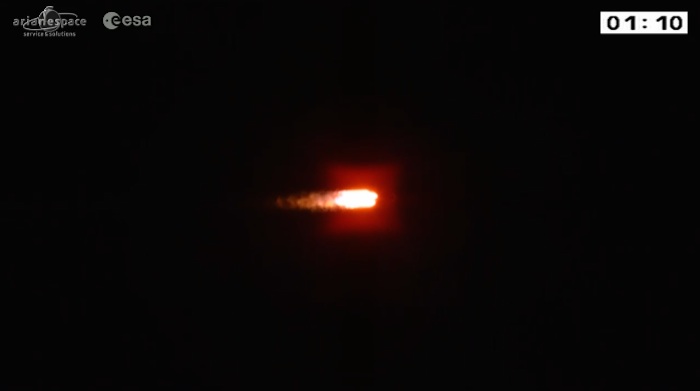
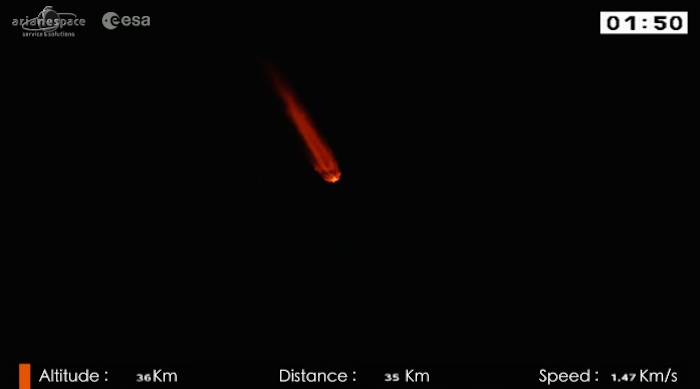
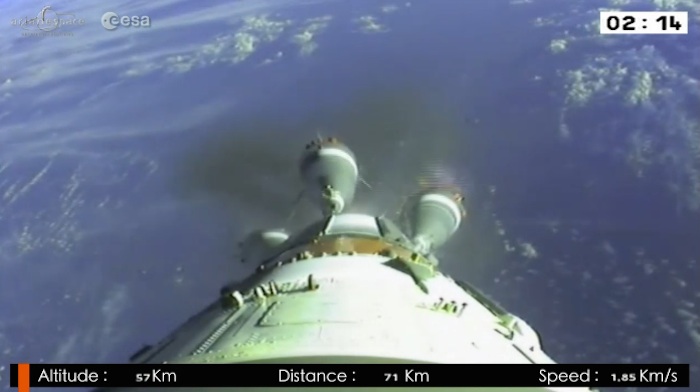
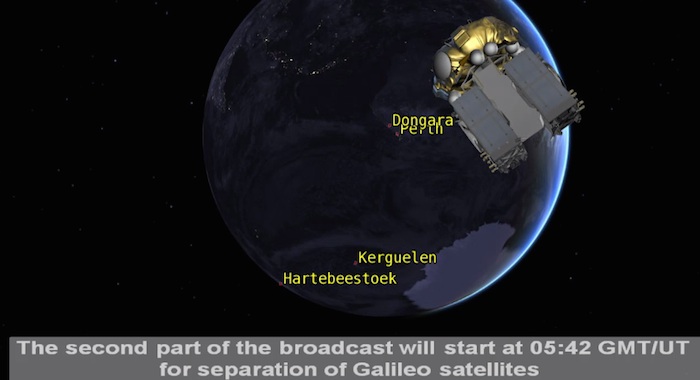
The Soyuz was then erected in a vertical position and suspended over the launch pad, held in place by four large support arms. This was followed by the 53-meter-tall mobile gantry’s move-in to protect the launcher, providing a safe environment for installation of the “upper composite” containing the Galileo satellites.
Galileo 9 and 10 are the fifth and sixth Galileo FOC (full operational capability) spacecraft, and have been designated “Alba” and “Oriana” — continuing the naming process after children who won a painting competition organized by the European Commission in 2011. The satellites were built by OHB System, with Surrey Satellite Technology Ltd. supplying their navigation payloads.
The European Commission is managing and funding Galileo’s FOC phase — during which the network’s complete operational and ground infrastructure is being deployed. The European Space Agency has been delegated as the design and procurement agent on the Commission’s behalf.
Two More this Year. Two further satellites are scheduled for launch by the end of this year. One is under test at ESA’s ESTEC technical centre in Noordwijk, the Netherlands, while the other has already completed its checks and is awaiting transportation to Kourou in the second half of October. In addition, the first satellite of the following batch (Galileo 13) has arrived at ESTEC and is undergoing its thermal-vacuum test. The next will arrive by mid-September.
Mission Control’s Mission. When the next pair of Galileo satellites is boosted into orbit on Friday, a team of mission control experts in Darmstadt, Germany, will spring into action, working around the clock to bring the duo through their critical first days in space. The fiery ascent to space will last just over nine minutes, after which the Fregat upper stage will fire twice to place the satellites into their release orbit.
Separation from Fregat, about 3 hours and 48 minutes into flight, marks the start of the critical early orbits for the team at ESA’s European Space Operation Centre in Darmstadt. Within the combined flight control team from ESA and France’s CNES space agency, each position is paired with its counterpart from the other agency and mixed “CNESOC” shifts will rotate to conduct operations around the clock. The same team conducts all the Galileo early operations alternately from ESOC and from the CNES control centre in Toulouse, France.
“Upon separation, the team will be very focused, and we’ll be watching for a number of critical events on the satellites to happen automatically at the right time and in the right order,” said ESA’s Liviu Stefanov, lead flight director for this phase. “The satellite must switch on, go into a basic flight configuration, deploy its solar wings for power, orient them towards the Sun and acquire Sun-pointing attitude. “As soon as we get communications, we’ll check its health and start sending commands to configure the satellite after completion of the automatic sequence and prepare it for the next major activity: pointing Galileo towards Earth.”
The intense activity will begin the 10-day early operations phase, during which the joint team will work 24 hours/day to oversee steps to prepare the satellites for handover to the Galileo Control Centre in Oberpfaffenhofen, for routine operations, and ESA’s Redu Centre in Belgium, for detailed payload testing.
.


Quelle: GPS
-
Update: 10.09.2015
.
ARIANESPACE FLIGHT VS12 / GALILEO FOC-M3, SAT 9–10
THE LAUNCH READINESS REVIEW (RAL) took place in Kourou on Wednesday, September 9, 2015 and authorized count-down operations for the GALILEO FOC-M3,SAT9-10 launch.
On the eighth launch of the year from the Guiana Space center in French Guiana, and the second with a Soyuz, Arianespace will orbit two satellites Galileo FOC-M3, satellites 9 & 10 for the European Space Agency.
It will be launched from the Soyuz launch complex ELS, in Kourou, French Guiana.
Liftoff is scheduled for Thursday, September 10, 2015, at:
• 11:08:10 pm, local time in French Guiana,
• 10:08:10 pm, in Washington, DC,
and on Friday, September 11 at:
• 02:08:10 UTC,
• 4:08:10 am, in Paris,
• 6:08:10 am, in Moscow.
Webcast starts 20 minutes before. You can also watch the video transmission live on your iPad, iPhone or Android 4+ devices, the Arianespace HD App is available for free. Follow the lauch live: www.arianespace.com
Quelle: arianespace
.
Update: 16.10 MESZ
.


Quelle: arianespace
-
Update: 11.09.2015
.
Erfolgreicher Start von Soyuz Flight VS12
.













Frams: arianespace
...
Arianespace's latest Galileo mission a success
With Soyuz launch of two satellites, Arianespace has now deployed one-third of the constellation
Arianespace has successfully launched the ninth and tenth satellites in the Galileo constellation for the European Commission, under a contract with the European Space Agency (ESA). The company's eighth launch of the year, and the 12th Soyuz launch from the Guiana Space Center (CSG), Europe's Spaceport in French Guiana, took place on September 10, 2015 at 11:08 pm local time. Arianespace is proud of its role in the ongoing deployment of the Galileo constellation, which will offer to all citizens, especially Europeans, a new satellite navigation service under civilian control.
Galileo, an emblematic European program
Europe initiated the Galileo program to develop a new global satellite navigation system. Under civilian control, it will offer a guaranteed, highprecision positioning service, with performance outpacing current solutions.
Galileo is the first joint infrastructure developed by ESA and financed by the European Union. It features innovative technologies developed in Europe to benefit all citizens.
Through Galileo, Europe will deploy its own satellite navigation system, offering multiple applications. It will provide five distinct services, all offering global coverage: general public, commercial, safety of life, public regulated, search & rescue. The first services will be available by 2016.
The Galileo FOC (Full Operational Capacity) satellites are built in Europe by OHB System of Bremen, Germany as prime contractor, with all payloads supplied by SSTL (Surrey Satellite Technology Ltd.), a British subsidiary of Airbus Defence and Space.
Arianespace continues to deploy the Galileo constellation
Following this latest successful mission, Arianespace has now launched one-third of the satellites comprising Galileo, or 10 out of a total of 30. The next Galileo launch is planned for December 2015, once again using a Soyuz launch vehicle.
The ES version of Ariane 5 will then take over, carrying four satellites on each mission, with a launch scheduled for the second half of 2016. In 2017 and 2018, one Soyuz and two Ariane 5 ES launchers will be used to orbit another ten satellites.
Shortly after the official announcement of this successful launch, Stéphane Israël, Chairman and CEO of Arianespace, said: "As a benchmark partner in the Galileo program, responsible for the constellation deployment, Arianespace upholds its commitment to guaranteeing independent access to space for Europe. This evening's launch, the sixth of eight scheduled European governmental missions this year, marks a further step towards European independence in satellite navigation – and we are very proud of our contribution. I would like to thank the European Union, especially the Commission's DG Growth, as well as ESA for continuing to place their trust in us. I would also like to thank the Russian space agency Roscosmos for their commitment to our partnership based on the Soyuz launcher, which reaffirms its dual vocation for commercial and governmental missions. And of course thanks to CNES/CSG, to all staff at the space center, and to the teams at Arianespace for the availability of the launch facilities and this very successful eighth launch of the year."
Quelle: arianespace
5123 Views
